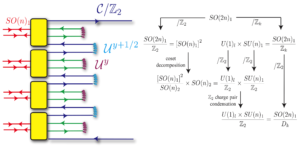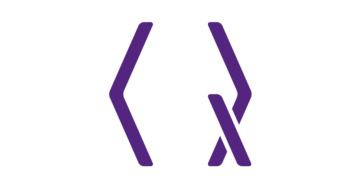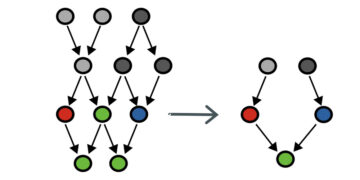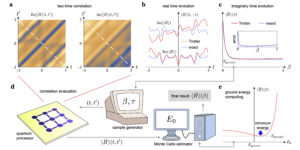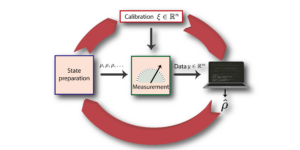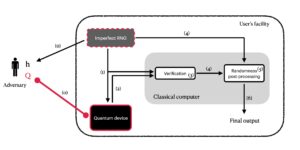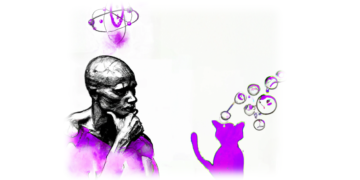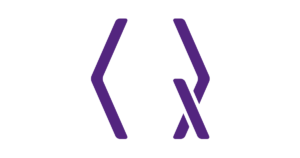1Deze auteurs hebben in gelijke mate bijgedragen aan dit werk
2Dipartimento di Fisica e Astronomia "G. Galilei", via Marzolo 8, I-35131, Padova, Italy
3INFN, Sezione di Padova, via Marzolo 8, I-35131, Padua, Italië
4Dipartimento di Fisica, Università di Pavia, Via Bassi 6, I-27100, Pavia, Italië
5INFN Sezione di Pavia, Via Bassi 6, I-27100, Pavia, Italië
6Padua Quantum Technologies Research Center, Università degli Studi di Padova
7CNR-INO - Largo E. Fermi 6, I-50125, Firenze, Italy
8CINECA Quantum Computing Lab,Via Magnanelli, 6/3, 40033 Casalecchio di Reno, Bologna, Italië
Vind je dit artikel interessant of wil je het bespreken? Scite of laat een reactie achter op SciRate.
Abstract
Quantum Neural Networks (QNN) worden beschouwd als een kandidaat voor het behalen van kwantumvoordeel in het tijdperk van de Noisy Intermediate Scale Quantum Computer (NISQ). Er zijn verschillende QNN-architecturen voorgesteld en met succes getest op benchmarkdatasets voor machinaal leren. Kwantitatieve onderzoeken naar de door QNN gegenereerde verstrengeling zijn echter slechts voor een beperkt aantal qubits onderzocht. Tensornetwerkmethoden maken het mogelijk kwantumcircuits met een groot aantal qubits in een grote verscheidenheid aan scenario's te emuleren. Hier gebruiken we matrixproducttoestanden om recent bestudeerde QNN-architecturen te karakteriseren met willekeurige parameters tot vijftig qubits, wat aantoont dat hun verstrengeling, gemeten in termen van verstrengelingsentropie tussen qubits, neigt naar die van Haar gedistribueerde willekeurige toestanden naarmate de diepte van de QNN toeneemt. . We certificeren de willekeur van de kwantumtoestanden ook door de expressibiliteit van de circuits te meten, en door tools uit de willekeurige matrixtheorie te gebruiken. We laten een universeel gedrag zien voor de snelheid waarmee verstrengeling wordt gecreëerd in een bepaalde QNN-architectuur, en introduceren daarom een nieuwe maatstaf om de verstrengelingsproductie in QNN's te karakteriseren: de verstrengelingssnelheid. Onze resultaten karakteriseren de verstrengelingseigenschappen van kwantumneurale netwerken en leveren nieuw bewijs van de snelheid waarmee deze willekeurige eenheden benaderen.
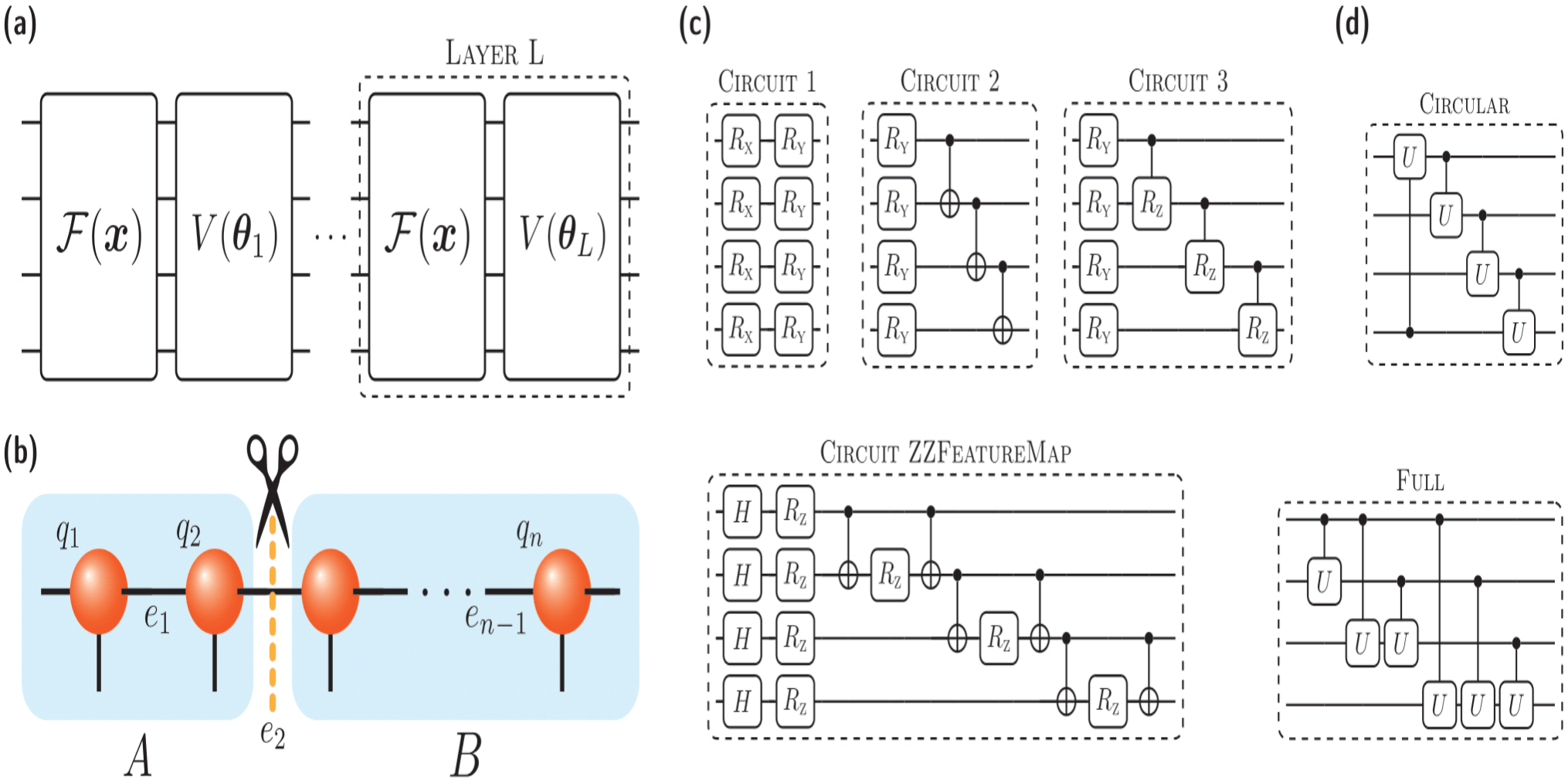
Featured image: Graphical representation of QNN and MPS. (a) QNN structure with alternating feature map F and variational ansatz V . Note that the ansatz parameters are different in each layer, while the feature map parameters are the same throughout the whole circuit. (b) MPS diagram. Each sphere is a tensor, representing a qubit qj . The entanglement entropy between bi-partitions A and B is computed by "cutting" the connecting edge ej . (c) Circuits analyzed in the manuscript, depicted with a linear entanglement topology, i.e. entangling gates are only applied between nearest neighbors on a line. (d) Different entanglement topologies: circular, with the first and last qubit of the line connected, and full, where the entangling gates are applied between each pair of qubits.
► BibTeX-gegevens
► Referenties
[1] Michael A. Nielsen and Isaac L. Chuang. ``Quantum computation and quantum information''. Cambridge University Press. Cambridge, UK (2010). 10th anniversary ed. (2010) edition.
https: / / doi.org/ 10.1017 / CBO9780511976667
[2] Ian Goodfellow, Yoshua Bengio, and Aaron Courville. ``Deep learning''. MIT Press. (2016). url: http://www.deeplearningbook.org.
http: / / www.deeplearningbook.org
[3] Yann LeCun, Yoshua Bengio, and Geoffrey Hinton. ``Deep learning''. Nature 521, 436–444 (2015).
https: / / doi.org/ 10.1038 / nature14539
[4] Alex Krizhevsky, Ilya Sutskever, and Geoffrey E. Hinton. ``Imagenet classification with deep convolutional neural networks''. In Proceedings of the 25th International Conference on Neural Information Processing Systems - Volume 1. Page 1097–1105. NIPS'12Red Hook, NY, USA (2012). Curran Associates Inc.
https: / / doi.org/ 10.1145 / 3065386
[5] David Silver, Aja Huang, Chris J. Maddison, Arthur Guez, Laurent Sifre, George van den Driessche, Julian Schrittwieser, Ioannis Antonoglou, Veda Panneershelvam, Marc Lanctot, Sander Dieleman, Dominik Grewe, John Nham, Nal Kalchbrenner, Ilya Sutskever, Timothy Lillicrap, Madeleine Leach, Koray Kavukcuoglu, Thore Graepel, and Demis Hassabis. ``Mastering the game of Go with deep neural networks and tree search''. Nature 529, 484–489 (2016).
https: / / doi.org/ 10.1038 / nature16961
[6] Jonas Degrave, Federico Felici, Jonas Buchli, Michael Neunert, Brendan Tracey, Francesco Carpanese, Timo Ewalds, Roland Hafner, Abbas Abdolmaleki, Diego de las Casas, Craig Donner, Leslie Fritz, Cristian Galperti, Andrea Huber, James Keeling, Maria Tsimpoukelli, Jackie Kay, Antoine Merle, Jean-Marc Moret, Seb Noury, Federico Pesamosca, David Pfau, Olivier Sauter, Cristian Sommariva, Stefano Coda, Basil Duval, Ambrogio Fasoli, Pushmeet Kohli, Koray Kavukcuoglu, Demis Hassabis, and Martin Riedmiller. ``Magnetic control of tokamak plasmas through deep reinforcement learning''. Nature 602, 414–419 (2022).
https://doi.org/10.1038/s41586-021-04301-9
[7] Jacob Biamonte, Peter Wittek, Nicola Pancotti, Patrick Rebentrost, Nathan Wiebe en Seth Lloyd. ``Kwantummachine learning''. Natuur 549, 195–202 (2017).
https: / / doi.org/ 10.1038 / nature23474
[8] Vedran Dunjko and Peter Wittek. ``A non-review of quantum machine learning: trends and explorations''. Quantum 4, 32 (2020).
https://doi.org/10.22331/qv-2020-03-17-32
[9] M. Cerezo, Andrew Arrasmith, Ryan Babbush, Simon C. Benjamin, Suguru Endo, Keisuke Fujii, Jarrod R. McClean, Kosuke Mitarai, Xiao Yuan, Lukasz Cincio, and et al. ``Variational quantum algorithms''. Nature Reviews Physics 3, 625–644 (2021).
https://doi.org/10.1038/s42254-021-00348-9
[10] S. Mangini, F. Tacchino, D. Gerace, D. Bajoni, and C. Macchiavello. ``Quantum computing models for artificial neural networks''. Europhysics Letters 134, 10002 (2021).
https://doi.org/10.1209/0295-5075/134/10002
[11] Kishor Bharti, Alba Cervera-Lierta, Thi Ha Kyaw, Tobias Haug, Sumner Alperin-Lea, Abhinav Anand, Matthias Degroote, Hermanni Heimonen, Jakob S. Kottmann, Tim Menke, Wai-Keong Mok, Sukin Sim, Leong-Chuan Kwek, en Alán Aspuru-Guzik. `` Lawaaierige kwantumalgoritmen op middelmatige schaal ''. Rev. Mod. Fys. 94, 015004 (2022).
https: / / doi.org/ 10.1103 / RevModPhys.94.015004
[12] John Preskill. ``Quantum Computing in het NISQ-tijdperk en daarna''. Kwantum 2, 79 (2018).
https://doi.org/10.22331/q-2018-08-06-79
[13] Alberto Peruzzo, Jarrod McClean, Peter Shadbolt, Man-Hong Yung, Xiao-Qi Zhou, Peter J. Love, Alán Aspuru-Guzik, and Jeremy L. O'Brien. ``A variational eigenvalue solver on a photonic quantum processor''. Nat. Commun. 5 (2014).
https: / / doi.org/ 10.1038 / ncomms5213
[14] Amira Abbas, David Sutter, Christa Zoufal, Aurelien Lucchi, Alessio Figalli, and Stefan Woerner. ``The power of quantum neural networks''. Nature Computational Science 1, 403–409 (2021).
https://doi.org/10.1038/s43588-021-00084-1
[15] Hsin-Yuan Huang, Richard Kueng, and John Preskill. ``Information-theoretic bounds on quantum advantage in machine learning''. Phys. Rev. Lett. 126, 190505 (2021).
https: / / doi.org/ 10.1103 / PhysRevLett.126.190505
[16] Hsin-Yuan Huang, Michael Broughton, Masoud Mohseni, Ryan Babbush, Sergio Boixo, Hartmut Neven, and Jarrod R. McClean. ``Power of data in quantum machine learning''. Nature Communications 12, 2631 (2021).
https://doi.org/10.1038/s41467-021-22539-9
[17] Franz J. Schreiber, Jens Eisert, and Johannes Jakob Meyer. ``Classical surrogates for quantum learning models'' (2022) arXiv:2206.11740.
arXiv: 2206.11740
[18] Thomas Hubregtsen, Josef Pichlmeier, Patrick Stecher, and Koen Bertels. ``Evaluation of parameterized quantum circuits: On the relation between classification accuracy, expressibility, and entangling capability''. Quantum Machine Intelligence 3, 9 (2021).
https: / / doi.org/ 10.1007 / s42484-021-00038-w
[19] M. Cerezo, Akira Sone, Tyler Volkoff, Lukasz Cincio, and Patrick J. Coles. ``Cost function dependent barren plateaus in shallow parametrized quantum circuits''. Nat. Commun. 12 (2021).
https: / / doi.org/ 10.1038 / s41467-021-21728-w
[20] Iris Cong, Soonwon Choi, and Mikhail D. Lukin. ``Quantum convolutional neural networks''. Nature Physics 15, 1273–1278 (2019).
https://doi.org/10.1038/s41567-019-0648-8
[21] Johannes Jakob Meyer, Marian Mularski, Elies Gil-Fuster, Antonio Anna Mele, Francesco Arzani, Alissa Wilms, and Jens Eisert. ``Exploiting symmetry in variational quantum machine learning''. PRX Quantum 4, 010328 (2023).
https: / / doi.org/ 10.1103 / PRXQuantum.4.010328
[22] Andrea Skolik, Michele Cattelan, Sheir Yarkoni, Thomas Bäck, and Vedran Dunjko. ``Equivariant quantum circuits for learning on weighted graphs''. npj Quantum Information 9, 47 (2023).
https: / / doi.org/ 10.1038 / s41534-023-00710-y
[23] Sukin Sim, Peter D. Johnson, and Alán Aspuru-Guzik. ``Expressibility and entangling capability of parameterized quantum circuits for hybrid quantum-classical algorithms''. Adv. Quantum Technol. 2, 1900070 (2019).
https: / / doi.org/ 10.1002 / qute.201900070
[24] Adrián Pérez-Salinas, Alba Cervera-Lierta, Elies Gil-Fuster, and José I. Latorre. ``Data re-uploading for a universal quantum classifier''. Quantum 4, 226 (2020).
https://doi.org/10.22331/q-2020-02-06-226
[25] Maria Schuld, Ryan Sweke, and Johannes Jakob Meyer. ``Effect of data encoding on the expressive power of variational quantum-machine-learning models''. Phys. Rev. A 103, 032430 (2021).
https: / / doi.org/ 10.1103 / PhysRevA.103.032430
[26] Francesco Tacchino, Stefano Mangini, Panagiotis Kl. Barkoutsos, Chiara Macchiavello, Dario Gerace, Ivano Tavernelli, and Daniele Bajoni. ``Variational learning for quantum artificial neural networks''. IEEE Transactions on Quantum Engineering 2, 1–10 (2021).
https: / / doi.org/ 10.1109 / TQE.2021.3062494
[27] B Jaderberg, L W Anderson, W Xie, S Albanie, M Kiffner, and D Jaksch. ``Quantum self-supervised learning''. Quantum Science and Technology 7, 035005 (2022).
https:///doi.org/10.1088/2058-9565/ac6825
[28] David A. Meyer and Nolan R. Wallach. ``Global entanglement in multiparticle systems''. Journal of Mathematical Physics 43, 4273–4278 (2002).
https: / / doi.org/ 10.1063 / 1.1497700
[29] Pietro Silvi, Ferdinand Tschirsich, Matthias Gerster, Johannes Jünemann, Daniel Jaschke, Matteo Rizzi, and Simone Montangero. ``The tensor networks anthology: Simulation techniques for many-body quantum lattice systems''. SciPost Physics Lecture Notes (2019).
https:///doi.org/10.21468/scipostphyslectnotes.8
[30] S. Montangero. ``Introduction to tensor network methods''. Springer International Publishing. Cham, CH (2018).
https://doi.org/10.1007/978-3-030-01409-4
[31] J. Eisert. ``Entanglement and tensor network states'' (2013). arXiv:1308.3318.
arXiv: 1308.3318
[32] Sebastian Paeckel, Thomas Köhler, Andreas Swoboda, Salvatore R. Manmana, Ulrich Schollwöck en Claudius Hubig. ``Tijdsevolutiemethoden voor matrixproducttoestanden''. Annals of Physics 411, 167998 (2019).
https: / / doi.org/ 10.1016 / j.aop.2019.167998
[33] Patrick Hayden, Debbie W. Leung, and Andreas Winter. ``Aspects of Generic Entanglement''. Communications in Mathematical Physics 265, 95–117 (2006).
https://doi.org/10.1007/s00220-006-1535-6
[34] Elizabeth S. Meckes. ``The Random Matrix Theory of the Classical Compact Groups''. Cambridge Tracts in Mathematics. Cambridge University Press. Cambridge (2019).
https: / / doi.org/ 10.1017 / 9781108303453
[35] Alan Edelman and N. Raj Rao. ``Random matrix theory''. Acta Numerica 14, 233–297 (2005).
https: / / doi.org/ 10.1017 / S0962492904000236
[36] Don N. Page. ``Average entropy of a subsystem''. Phys. Rev. Lett. 71, 1291–1294 (1993).
https: / / doi.org/ 10.1103 / PhysRevLett.71.1291
[37] Jarrod R McClean, Jonathan Romero, Ryan Babbush en Alán Aspuru-Guzik. ``De theorie van variatie-hybride kwantum-klassieke algoritmen''. Nieuwe J. Phys. 18, 023023 (2016).
https://doi.org/10.1088/1367-2630/18/2/023023
[38] Francisco Javier Gil Vidal and Dirk Oliver Theis. ``Input redundancy for parameterized quantum circuits''. Front. Phys. 8, 297 (2020).
https: / / doi.org/ 10.3389 / fphy.2020.00297
[39] E. Torrontegui and J. J. Garcia-Ripoll. ``Unitary quantum perceptron as efficient universal approximator''. EPL 125, 30004 (2019).
https://doi.org/10.1209/0295-5075/125/30004
[40] Jarrod R. McClean, Sergio Boixo, Vadim N. Smelyanskiy, Ryan Babbush, and Hartmut Neven. ``Barren plateaus in quantum neural network training landscapes''. Nat. Commun. 9, 4812 (2018).
https://doi.org/10.1038/s41467-018-07090-4
[41] Maria Schuld, Ville Bergholm, Christian Gogolin, Josh Izaac en Nathan Killoran. ``Analytische gradiënten evalueren op kwantumhardware''. Fys. Rev.A 99, 032331 (2019).
https: / / doi.org/ 10.1103 / PhysRevA.99.032331
[42] Andrew Arrasmith, M. Cerezo, Piotr Czarnik, Lukasz Cincio, and Patrick J. Coles. ``Effect of barren plateaus on gradient-free optimization''. Quantum 5, 558 (2021).
https://doi.org/10.22331/q-2021-10-05-558
[43] Zoë Holmes, Kunal Sharma, M. Cerezo, and Patrick J. Coles. ``Connecting ansatz expressibility to gradient magnitudes and barren plateaus''. PRX Quantum 3, 010313 (2022).
https: / / doi.org/ 10.1103 / PRXQuantum.3.010313
[44] Carlos Ortiz Marrero, Mária Kieferová en Nathan Wiebe. ``Door verstrengeling veroorzaakte dorre plateaus''. PRX Quantum 2, 040316 (2021).
https: / / doi.org/ 10.1103 / PRXQuantum.2.040316
[45] Samson Wang, Enrico Fontana, M. Cerezo, Kunal Sharma, Akira Sone, Lukasz Cincio en Patrick J. Coles. ``Door ruis geïnduceerde kale plateaus in variatiekwantumalgoritmen''. Natuurcommunicatie 12, 6961 (2021).
https://doi.org/10.1038/s41467-021-27045-6
[46] Christoph Dankert, Richard Cleve, Joseph Emerson, and Etera Livine. ``Exact and approximate unitary 2-designs and their application to fidelity estimation''. Physical Review A 80 (2009).
https: / / doi.org/ 10.1103 / physreva.80.012304
[47] Andrew Arrasmith, Zoë Holmes, Marco Cerezo en Patrick J Coles. ``Equivalentie van kwantumonvruchtbare plateaus met kostenconcentratie en smalle kloven''. Kwantumwetenschap en technologie 7, 045015 (2022).
https://doi.org/10.1088/2058-9565/ac7d06
[48] Stefan H. Sack, Raimel A. Medina, Alexios A. Michailidis, Richard Kueng en Maksym Serbyn. ``Onvruchtbare plateaus vermijden met behulp van klassieke schaduwen''. PRX Quantum 3, 020365 (2022).
https: / / doi.org/ 10.1103 / PRXQuantum.3.020365
[49] Taylor L. Patti, Khadijeh Najafi, Xun Gao en Susanne F. Yelin. ``Verstrengeling bedacht de verzachting van het onvruchtbare plateau''. Fys. Onderzoek 3, 033090 (2021).
https: / / doi.org/ 10.1103 / PhysRevResearch.3.033090
[50] Zi-Wen Liu, Seth Lloyd, Elton Zhu, and Huangjun Zhu. ``Entanglement, quantum randomness, and complexity beyond scrambling''. Journal of High Energy Physics 2018, 41 (2018).
https: / / doi.org/ 10.1007 / JHEP07 (2018) 041
[51] Edward Grant, Leonard Wossnig, Mateusz Ostaszewski en Marcello Benedetti. ``Een initialisatiestrategie voor het aanpakken van dorre plateaus in geparametriseerde kwantumcircuits''. Kwantum 3, 214 (2019).
https://doi.org/10.48550/arXiv.1903.05076
[52] Tyler Volkoff en Patrick J Coles. ``Grote gradiënten via correlatie in willekeurig geparametriseerde kwantumcircuits''. Kwantumwetenschap en technologie 6, 025008 (2021).
https:///doi.org/10.1088/2058-9565/abd891
[53] Andrea Skolik, Jarrod R McClean, Masoud Mohseni, Patrick van der Smagt, and Martin Leib. ``Layerwise learning for quantum neural networks''. Quantum Machine Intelligence 3, 1–11 (2021).
https://doi.org/10.1007/s42484-020-00036-4
[54] Joonho Kim and Yaron Oz. ``Entanglement diagnostics for efficient vqa optimization''. Journal of Statistical Mechanics: Theory and Experiment 2022, 073101 (2022).
https:///doi.org/10.1088/1742-5468/ac7791
[55] Vojtěch Havlíček, Antonio D. Córcoles, Kristan Temme, Aram W. Harrow, Abhinav Kandala, Jerry M. Chow, and Jay M. Gambetta. ``Supervised learning with quantum-enhanced feature spaces''. Nature 567, 209–212 (2019).
https://doi.org/10.1038/s41586-019-0980-2
[56] Aram W. Harrow and Richard A. Low. ``Random Quantum Circuits are Approximate 2-designs''. Communications in Mathematical Physics 291, 257–302 (2009).
https://doi.org/10.1007/s00220-009-0873-6
[57] Jonas Haferkamp en Nicholas Hunter-Jones. ``Verbeterde spectrale gaten voor willekeurige kwantumcircuits: grote lokale dimensies en alles-tot-alles-interacties''. Fys. A 104, 022417 (2021).
https: / / doi.org/ 10.1103 / PhysRevA.104.022417
[58] Maria Schuld. ``Supervised quantum machine learning models are kernel methods'' (2021) arXiv:2101.11020.
arXiv: 2101.11020
[59] Sofiene Jerbi, Lukas J Fiderer, Hendrik Poulsen Nautrup, Jonas M Kübler, Hans J Briegel, and Vedran Dunjko. ``Quantum machine learning beyond kernel methods''. Nature Communications 14, 517 (2023).
https: / / doi.org/ 10.1038 / s41467-023-36159-y
[60] Seth Lloyd. ``Quantum approximate optimization is computationally universal'' (2018) arXiv:1812.11075.
arXiv: 1812.11075
[61] M. E. S. Morales, J. D. Biamonte, and Z. Zimborás. ``On the universality of the quantum approximate optimization algorithm''. Quantum Information Processing 19, 291 (2020).
https://doi.org/10.1007/s11128-020-02748-9
[62] Fernando G. S. L. Brandão, Aram W. Harrow, and Michał Horodecki. ``Local Random Quantum Circuits are Approximate Polynomial-Designs''. Communications in Mathematical Physics 346, 397–434 (2016).
https://doi.org/10.1007/s00220-016-2706-8
[63] Aram W Harrow and Saeed Mehraban. ``Approximate unitary t-designs by short random quantum circuits using nearest-neighbor and long-range gates''. Communications in Mathematical PhysicsPages 1–96 (2023).
https: / / doi.org/ 10.1007 / s00220-023-04675-z
[64] Pasquale Calabrese and John Cardy. ``Evolution of entanglement entropy in one-dimensional systems''. Journal of Statistical Mechanics: Theory and Experiment 2005, P04010 (2005).
https://doi.org/10.1088/1742-5468/2005/04/p04010
[65] Tianci Zhou en Adam Nahum. ``Opkomende statistische mechanica van verstrengeling in willekeurige unitaire circuits''. Fys. B 99, 174205 (2019).
https: / / doi.org/ 10.1103 / PhysRevB.99.174205
[66] Adam Nahum, Jonathan Ruhman, Sagar Vijay, and Jeongwan Haah. ``Quantum entanglement growth under random unitary dynamics''. Phys. Rev. X 7, 031016 (2017).
https: / / doi.org/ 10.1103 / PhysRevX.7.031016
[67] M. Aeberhard, Stefan & Forina. ``Wine''. UCI Machine Learning Repository (1991). DOI: https://doi.org/10.24432/C5PC7J.
https:///doi.org/10.24432/C5PC7J
[68] Milan Zwitter, Matjaz & Soklic. ``Breast Cancer''. UCI Machine Learning Repository (1988). DOI: https://doi.org/10.24432/C51P4M.
https:///doi.org/10.24432/C51P4M
[69] Marko Žnidarič. ``Entanglement of random vectors''. Journal of Physics A: Mathematical and Theoretical 40, F105 (2006).
https://doi.org/10.1088/1751-8113/40/3/F04
[70] Daniel Jaschke and Simone Montangero. ``Is quantum computing green? an estimate for an energy-efficiency quantum advantage''. Quantum Science and Technology (2022).
https:///doi.org/10.1088/2058-9565/acae3e
[71] V A Marčenko and L A Pastur. ``Distribution of eigenvalues for some sets of random matrices''. Mathematics of the USSR-Sbornik 1, 457 (1967).
https://doi.org/10.1070/SM1967v001n04ABEH001994
[72] Zbigniew Puchała, Łukasz Pawela, and Karol Życzkowski. ``Distinguishability of generic quantum states''. Physical Review A 93, 062112 (2016).
https: / / doi.org/ 10.1103 / PhysRevA.93.062112
[73] Maxime Dupont, Nicolas Didier, Mark J. Hodson, Joel E. Moore, and Matthew J. Reagor. ``Entanglement perspective on the quantum approximate optimization algorithm''. Phys. Rev. A 106, 022423 (2022).
https: / / doi.org/ 10.1103 / PhysRevA.106.022423
[74] Andreas J. C. Woitzik, Panagiotis Kl. Barkoutsos, Filip Wudarski, Andreas Buchleitner, and Ivano Tavernelli. ``Entanglement production and convergence properties of the variational quantum eigensolver''. Phys. Rev. A 102, 042402 (2020).
https: / / doi.org/ 10.1103 / PhysRevA.102.042402
[75] Michael Ragone, Paolo Braccia, Quynh T. Nguyen, Louis Schatzki, Patrick J. Coles, Frederic Sauvage, Martin Larocca, and M. Cerezo. ``Representation theory for geometric quantum machine learning'' (2022) arXiv:2210.07980.
arXiv: 2210.07980
[76] Kunal Sharma, M. Cerezo, Zoë Holmes, Lukasz Cincio, Andrew Sornborger, and Patrick J. Coles. ``Reformulation of the no-free-lunch theorem for entangled datasets''. Phys. Rev. Lett. 128, 070501 (2022).
https: / / doi.org/ 10.1103 / PhysRevLett.128.070501
[77] Martin Larocca, Nathan Ju, Diego García-Martín, Patrick J. Coles, and M. Cerezo. ``Theory of overparametrization in quantum neural networks'' (2021) arXiv:2109.11676.
arXiv: 2109.11676
[78] Bobak Toussi Kiani, Seth Lloyd, and Reevu Maity. ``Learning unitaries by gradient descent'' (2020) arXiv:2001.11897.
arXiv: 2001.11897
[79] Eric R. Anschuetz and Bobak T. Kiani. ``Quantum variational algorithms are swamped with traps''. Nature Communications 13 (2022).
https://doi.org/10.1038/s41467-022-35364-5
[80] Md Sajid Anis et al. ``Qiskit: An open-source framework for quantum computing''. Zenodo (2021).
https: / / doi.org/ 10.5281 / zenodo.2562111
[81] Marco Ballarin. ``Quantum computer simulation via tensor networks''. Università degli Studi di Padova, Master Thesis (2021). url: https://hdl.handle.net/20.500.12608/21799.
https: / / hdl.handle.net/ 20.500.12608/21799
[82] Ville Bergholm, Josh Izaac, Maria Schuld, Christian Gogolin, M Sohaib Alam, Shahnawaz Ahmed, Juan Miguel Arrazola, Carsten Blank, Alain Delgado, Soran Jahangiri, et al. ``Pennylane: Automatic differentiation of hybrid quantum-classical computations'' (2018). arXiv:1811.04968.
arXiv: 1811.04968
[83] Julian Havil. ``Gamma: exploring euler's constant''. The Australian Mathematical SocietyPage 250 (2003). url: https://ieeexplore.ieee.org/document/9452347.
https: / / ieeexplore.ieee.org/ document / 9452347
[84] Juan Carlos Garcia-Escartin and Pedro Chamorro-Posada. ``Equivalent quantum circuits'' (2011). arXiv:1110.2998.
arXiv: 1110.2998
[85] Karol Życzkowski and Hans-Jürgen Sommers. ``Average fidelity between random quantum states''. Phys. Rev. A 71, 032313 (2005).
https: / / doi.org/ 10.1103 / PhysRevA.71.032313
Geciteerd door
[1] Yuchen Guo and Shuo Yang, "Noise effects on purity and quantum entanglement in terms of physical implementability", npj Quantum-informatie 9, 11 (2023).
[2] Dirk Heimann, Gunnar Schönhoff, and Frank Kirchner, "Learning capability of parametrized quantum circuits", arXiv: 2209.10345, (2022).
Bovenstaande citaten zijn afkomstig van SAO / NASA ADS (laatst bijgewerkt met succes 2023-06-06 14:08:58). De lijst is mogelijk onvolledig omdat niet alle uitgevers geschikte en volledige citatiegegevens verstrekken.
On Crossref's geciteerde dienst er zijn geen gegevens gevonden over het citeren van werken (laatste poging 2023-06-06 14:08:57).
Dit artikel is gepubliceerd in Quantum onder de Creative Commons Naamsvermelding 4.0 Internationaal (CC BY 4.0) licentie. Het auteursrecht blijft berusten bij de oorspronkelijke houders van auteursrechten, zoals de auteurs of hun instellingen.
- Door SEO aangedreven content en PR-distributie. Word vandaag nog versterkt.
- PlatoAiStream. Web3 gegevensintelligentie. Kennis versterkt. Toegang hier.
- De toekomst slaan met Adryenn Ashley. Toegang hier.
- Koop en verkoop aandelen in PRE-IPO-bedrijven met PREIPO®. Toegang hier.
- Bron: https://quantum-journal.org/papers/q-2023-05-31-1023/
- :is
- :niet
- :waar
- $UP
- 1
- 10
- 102
- 10
- 11
- 12
- 13
- 14
- 15%
- 16
- 17
- 20
- 2001
- 2005
- 2006
- 2011
- 2012
- 2013
- 2014
- 2015
- 2016
- 2017
- 2018
- 2019
- 2020
- 2021
- 2022
- 2023
- 2030
- 214
- 22
- 23
- 24
- 25
- 250
- 26
- 27
- 28
- 30
- 31
- 39
- 40
- 49
- 50
- 500
- 60
- 66
- 67
- 7
- 70
- 72
- 75
- 77
- 8
- 80
- 84
- 9
- a
- Aaron
- Abbas
- boven
- SAMENVATTING
- toegang
- nauwkeurigheid
- het bereiken van
- Adam
- aanpakken
- Voordeel
- voorkeuren
- AL
- Alan
- alex
- algoritme
- algoritmen
- Alles
- toelaten
- ook
- an
- analytisch
- en
- Andrew
- anna
- Verjaardag
- elke
- Aanvraag
- toegepast
- benaderend
- architectuur
- ZIJN
- Arthur
- kunstmatig
- kunstmatige neurale netwerken
- AS
- At
- Australisch
- auteur
- auteurs
- Automatisch
- dor
- BE
- geweest
- criterium
- Benjamin
- tussen
- Verder
- blanco
- Breken
- by
- Cambridge
- Kanker
- kandidaat
- Centreren
- certificeren
- karakteriseren
- chow
- Chris
- classificatie
- commentaar
- Volk
- Communicatie
- compleet
- ingewikkeldheid
- berekening
- berekeningen
- computer
- computergebruik
- concentratie
- Conferentie
- gekoppeld blijven
- Wij verbinden
- bijgevolg
- beschouwd
- constante
- bijgedragen
- onder controle te houden
- Convergentie
- auteursrecht
- Correlatie
- Kosten
- Craig
- aangemaakt
- snijdend
- Daniel
- gegevens
- datasets
- David
- David Silver
- Debbie
- deep
- diepe neurale netwerken
- Het
- afhankelijk
- diepte
- Diego
- anders
- Afmeting
- bespreken
- verdeeld
- don
- dynamica
- e
- E & T
- elk
- ed
- rand
- editie
- Edward
- duurt
- doeltreffend
- energie-niveau
- Engineering
- even
- Tijdperk
- schatting
- Ether (ETH)
- bewijzen
- experiment
- Verkennen
- expressief
- Kenmerk
- Federico
- weinig
- trouw
- Voornaam*
- Voor
- gevonden
- Achtergrond
- Francisco
- oppompen van
- voor
- vol
- functie
- spel
- GAO
- hiaten
- Gates
- George
- gegeven
- Go
- gradiënten
- toe te kennen
- grafieken
- Groen
- Groep
- handvat
- Hardware
- harvard
- Hebben
- hier
- Hoge
- houders
- Echter
- http
- HTTPS
- Huang
- Hybride
- hybride kwantum-klassiek
- i
- IEEE
- beeld
- in
- Inc
- meer
- informatie
- instellingen
- Intelligentie
- interacties
- interessant
- Gemiddeld
- Internationale
- voorstellen
- JavaScript
- John
- Johnson
- tijdschrift
- Kim
- laboratorium
- Groot
- LAS
- Achternaam*
- lagen
- leren
- Verlof
- lezing
- Vergunning
- Lijn
- Lijst
- lokaal
- Louis
- liefde
- Laag
- machine
- machine learning
- kaart
- kader
- Mark
- Martin
- meester
- wiskundig
- wiskunde
- Matrix
- Matthew
- max-width
- Mei..
- mcschoon
- maatregel
- het meten van
- mechanica
- methoden
- Meyer
- Michael
- MILAAN
- MIT
- verzachting
- modellen
- mok
- Maand
- NATUUR
- buren
- netwerk
- netwerken
- Neural
- neuraal netwerk
- neurale netwerken
- New
- Nguyen
- Nicolas
- geen
- Geluid
- Opmerkingen
- aantal
- NY
- of
- Olivier
- on
- Slechts
- open
- open source
- optimalisatie
- or
- origineel
- onze
- pagina
- paar
- Paul
- Papier
- parameters
- patrick
- perspectief
- Peter
- Fysiek
- Fysica
- Peter
- Plato
- Plato gegevensintelligentie
- PlatoData
- energie
- pers
- werkzaamheden
- verwerking
- Gegevensverwerker
- Product
- Productie
- vastgoed
- voorgestelde
- zorgen voor
- biedt
- gepubliceerde
- uitgever
- uitgevers
- Reclame
- qiskit
- kwantitatief
- Quantum
- kwantumvoordeel
- kwantumalgoritmen
- Quantumcomputer
- quantum computing
- kwantumverstrengeling
- kwantuminformatie
- Quantum machine learning
- qubit
- qubits
- willekeurige
- willekeurigheid
- tarief
- onlangs
- referenties
- versterking van leren
- relatie
- stoffelijk overschot
- Reno
- bewaarplaats
- vertegenwoordiging
- vertegenwoordigen
- onderzoek
- Resultaten
- beoordelen
- Recensies
- Richard
- Roland
- Ryan
- s
- dezelfde
- Springen
- Scale
- scenario's
- Wetenschap
- Wetenschap en Technologie
- Ontdek
- Sets
- verscheidene
- ondiep
- Sharma
- Bermuda's
- tonen
- Zilver
- SIM
- Simon
- simulatie
- sommige
- ruimten
- Spectraal
- snelheid
- Staten
- statistisch
- Strategie
- structuur
- bestudeerd
- studies
- Met goed gevolg
- dergelijk
- geschikt
- Systems
- technieken
- Technologies
- Technologie
- termen
- getest
- dat
- De
- hun
- theoretisch
- theorie
- Deze
- scriptie
- dit
- Door
- overal
- Tim
- Timo
- Titel
- naar
- tools
- Trainingen
- Transacties
- vallen
- boom
- Trends
- Uk
- voor
- Universeel
- universiteit-
- bijgewerkt
- URL
- USA
- gebruik
- variëteit
- via
- volume
- W
- willen
- was
- we
- GOED
- welke
- en
- geheel
- breed
- Winter
- Met
- Bedrijven
- X
- jaar
- Yuan
- zephyrnet

